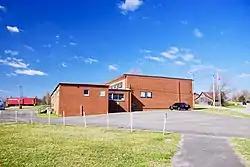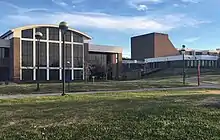New Market | |
|---|---|
 New Market City Hall | |
 Location of New Market in Jefferson County, Tennessee | |
| Coordinates: 36°6′6″N 83°32′59″W / 36.10167°N 83.54972°W | |
| Country | United States |
| State | Tennessee |
| County | Jefferson |
| Settled | 1788[1] |
| Incorporated | 1911[2] |
| Area | |
| • Total | 4.23 sq mi (10.96 km2) |
| • Land | 4.23 sq mi (10.96 km2) |
| • Water | 0.00 sq mi (0.00 km2) |
| Elevation | 1,073 ft (327 m) |
| Population | |
| • Total | 1,349 |
| • Density | 318.69/sq mi (123.04/km2) |
| Time zone | UTC-5 (Eastern (EST)) |
| • Summer (DST) | UTC-4 (EDT) |
| ZIP code | 37820 |
| Area code | 865 |
| FIPS code | 47-52940[5] |
| GNIS feature ID | 1295602[6] |
New Market is a town in Jefferson County, Tennessee, United States. It is part of the Morristown metropolitan area. The population was 1,334 at the 2010 census and 1,349 at the 2020 census.[7]
History
On September 24, 1904, two passenger trains collided head-on near New Market, killing a large, unknown number of passengers. Different sources give different values for the number of deaths, ranging from 54 to 113.[8][9][10]
There are many historical buildings in New Market, including the New Market Presbyterian Church which was built in 1885. The church was listed on the National Register of Historic Places in 1998.
Citing concerns of annexation by Jefferson City, New Market would reincorporate as a town in 1977.[11]
New Market is the current home of the Highlander Research and Education Center.[12]
Norfolk Southern intermodal project controversy
In 2009, Norfolk Southern Railway released plans of a proposed 1,300 acres (5.3 km2) intermodal freight transport truck-and-train facility in New Market as a part of the US$2.5 billion Crescent Corridor project in a US$133 million private-public partnership with state and Jefferson County officials.[13][14] The proposed facility if completed would have generated 77 on-site jobs, 1,700 related-industry jobs in Jefferson and surrounding counties, and the potential of an annual income of US$60 million dollars a year.[13] The project received extensive NIMBY backlash from an organized group of affected property owners and farmers, citing the massive loss of land as a negative impact on Jefferson County's agricultural industry.[15]
The project would also have required the funding of at least US$23 million dollars in off-site costs, such as transportation and utility infrastructure upgrades.[16] Those in opposition to the project spread misinformation suggesting that Jefferson County would have pay the total amount in infrastructure upgrades for the project from tax increases. Norfolk Southern officials corrected this falsehood, saying that the company would fund the infrastructure upgrades rather than any government entity.[13]
In 2011, Norfolk Southern acquired several parcels of land in New Market and proposals for an on-site logistics park were dropped after a developer pulled out of its deal with Norfolk Southern.[16]
The project status has remained stagnant since 2015, as Norfolk had no plans of constructing the facility in the short-term future, but plans on having the site property as a "long-term investment" according to a press release by the company's public relations director.[17]
Geography
New Market is located in west-central Jefferson County at 36°6′6″N 83°32′59″W / 36.10167°N 83.54972°W (36.101625, -83.549698).[18] It is bordered to the east by Jefferson City.
U.S. Route 11E (Andrew Johnson Highway) passes through the town, leading northeast 3 miles (5 km) to Jefferson City and 19 miles (31 km) to Morristown, and southwest 24 miles (39 km) to Knoxville.
According to the United States Census Bureau, New Market has a total area of 4.1 square miles (10.7 km2), all land.[7] The town sits in the valley of Lost Creek, a west-flowing tributary of the Holston River.
Demographics
| Census | Pop. | Note | %± |
|---|---|---|---|
| 1880 | 354 | — | |
| 1980 | 1,216 | — | |
| 1990 | 1,086 | −10.7% | |
| 2000 | 1,234 | 13.6% | |
| 2010 | 1,334 | 8.1% | |
| 2020 | 1,349 | 1.1% | |
| Sources:[19][20][4] | |||
2020 census
| Race | Number | Percentage |
|---|---|---|
| White (non-Hispanic) | 1,165 | 86.36% |
| Black or African American (non-Hispanic) | 31 | 2.3% |
| Native American | 5 | 0.37% |
| Asian | 3 | 0.22% |
| Pacific Islander | 1 | 0.07% |
| Other/Mixed | 68 | 5.04% |
| Hispanic or Latino | 76 | 5.63% |
As of the 2020 United States census, there were 1,349 people, 568 households, and 410 families residing in the town.
2000 census
As of the census[5] of 2000, there were 1,234 people, 473 households, and 366 families residing in the town. The population density was 479.2 inhabitants per square mile (185.0/km2). There were 521 housing units at an average density of 202.3 per square mile (78.1/km2). The racial makeup of the town was 92.38% White, 3.89% African American, 0.08% Native American, 0.41% Asian, 2.11% from other races, and 1.13% from two or more races. Hispanic or Latino of any race were 3.65% of the population.
There were 473 households, out of which 30.2% had children under the age of 18 living with them, 61.7% were married couples living together, 11.2% had a female householder with no husband present, and 22.6% were non-families. 20.7% of all households were made up of individuals, and 10.4% had someone living alone who was 65 years of age or older. The average household size was 2.61 and the average family size was 2.98.
In the town, the population was spread out, with 23.9% under the age of 18, 8.1% from 18 to 24, 28.7% from 25 to 44, 25.3% from 45 to 64, and 14.0% who were 65 years of age or older. The median age was 38 years. For every 100 females, there were 105.0 males. For every 100 females age 18 and over, there were 95.2 males.
The median income for a household in the town was $39,583, and the median income for a family was $45,298. Males had a median income of $29,828 versus $19,900 for females. The per capita income for the town was $17,439. About 4.3% of families and 5.7% of the population were below the poverty line, including 3.0% of those under age 18 and 15.7% of those age 65 or over.
Notable people
- Frances Hodgson Burnett (November 24, 1849 – October 29, 1924) was an English–American playwright and author. She is best known for her children's stories, in particular The Secret Garden, A Little Princess, and Little Lord Fauntleroy. She lived in New Market during her younger years.
- John Casper Branner (July 4, 1850 – March 1, 1922), geologist and academic, was born in New Market and lived there until two years of age.[22]
References
- ↑ Nancy Capace, Encyclopedia of Tennessee (North American Book Distributors, 2000), p. 209.
- ↑ Tennessee Blue Book, 2005-2006, pp. 618-625.
- ↑ "ArcGIS REST Services Directory". United States Census Bureau. Retrieved October 15, 2022.
- 1 2 "Census Population API". United States Census Bureau. Retrieved October 15, 2022.
- 1 2 "U.S. Census website". United States Census Bureau. Retrieved January 31, 2008.
- ↑ "US Board on Geographic Names". United States Geological Survey. October 25, 2007. Retrieved January 31, 2008.
- 1 2 "Geographic Identifiers: 2010 Census Summary File 1 (G001): New Market town, Tennessee". American Factfinder. U.S. Census Bureau. Archived from the original on February 13, 2020. Retrieved November 28, 2018.
- ↑ "New Market Wreck," From Tipple, Loom, & Rail, Smithsonian Institution "History Wired" website
- ↑ History of the New Market Train Wreck Archived 2013-12-02 at the Wayback Machine, New Market Elementary School website
- ↑ Knoxville News Sentinel Archived 2007-04-17 at the Wayback Machine
- ↑ Downing, Shirley (September 21, 1997). "Towns". The Commercial Appeal. Retrieved June 4, 2023.
- ↑ "Highlander Research and Education Center". highlandercenter.org. Retrieved November 8, 2017.
- 1 2 3 Wilson, Robert (June 14, 2009). "Are intermodal facility plans on or off the rails in Jefferson County?". Knoxville News Sentinel. Retrieved September 2, 2020.
- ↑ Cagle, Frank. "Do the Right Thing". MetroPulse. Archived from the original on October 27, 2009. Retrieved September 2, 2020.
- ↑ Matheny, Jim (May 27, 2009). "Knoxville residents rail against proposed Norfolk Southern terminal". Brotherhood of Locomotive Engineers and Trainmen. WBIR-TV. Retrieved September 2, 2020.
- 1 2 Marcum, Ed (June 12, 2011). "Uncertainty over intermodal facility has some residents of New Market on edge". Knoxville News Sentinel. Retrieved September 2, 2020.
- ↑ Depew, Jake (January 18, 2015). "Intermodal Project Still Without Steam". Jefferson County Post. Retrieved September 2, 2020.
- ↑ "US Gazetteer files: 2010, 2000, and 1990". United States Census Bureau. February 12, 2011. Retrieved April 23, 2011.
- ↑ "Census of Population and Housing: Decennial Censuses". United States Census Bureau. Retrieved March 4, 2012.
- ↑ "Incorporated Places and Minor Civil Divisions Datasets: Subcounty Resident Population Estimates: April 1, 2010 to July 1, 2012". Population Estimates. U.S. Census Bureau. Archived from the original on June 11, 2013. Retrieved December 11, 2013.
- ↑ "Explore Census Data". data.census.gov. Retrieved December 27, 2021.
- ↑ "John Casper Branner (1850–1922): Rock Star in Two Countries" (PDF). GSA Today. 32 (July): 36. July 2022. Retrieved October 23, 2022.
External links
- Municipal Technical Advisory Service entry for New Market – information on local government, elections, and link to charter


